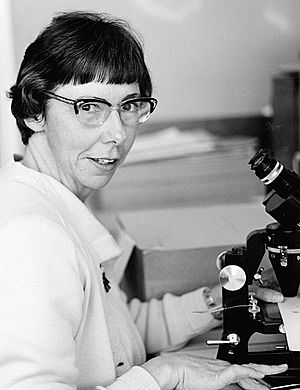Elizabeth Edgar facts for kids
Quick facts for kids
Elizabeth Edgar
|
|
|---|---|

Edgar c. 1970, DSIR
|
|
| Born | 27 December 1929 Christchurch, New Zealand
|
| Died | 1 January 2019 (aged 89) Christchurch, New Zealand
|
| Occupation | Botanist |
| Years active | 1952–2010 |
|
Notable work
|
Co-author of 3 of the 5 volumes of the series Flora of New Zealand |
| Relatives | Marion Fyfe (aunt) |
Elizabeth Edgar (born 27 December 1929 – died 1 January 2019) was an important New Zealand botanist. She was famous for writing and editing three of the five books in the Flora of New Zealand series. This series describes and organizes all the different types of plants found in New Zealand. Elizabeth Edgar was known as the top expert in New Zealand for naming and describing the country's plants.
Contents
Early Life and Education
Elizabeth Edgar was born in Christchurch, New Zealand, on 27 December 1929. She grew up in Spreydon with her two sisters. Her family were among the first European settlers in New Zealand. Her aunt, Marion Liddell Fyfe, was the first woman to teach zoology at the University of Otago.
Elizabeth went to Rangi Ruru Girls' School in Merivale. Her mother encouraged her to continue her studies at Canterbury University College. In 1950, Elizabeth earned a Bachelor of Arts degree in classics.
While working as a library assistant for the Department of Scientific and Industrial Research (DSIR), she kept studying. She earned a Bachelor of Science degree in botany in 1953. Elizabeth then took time off from DSIR to get her master's degree in 1957. Her master's research looked at the special features of some New Zealand Cotulas (a type of plant). She finished her PhD in 1960 at Canterbury University College. Her PhD research focused on the cells at the growing tips of certain plants.
Working with New Zealand Plants
Elizabeth Edgar returned to DSIR in 1959. She worked in the Botany Division at the Lincoln facility. She teamed up with Dr Lucy Moore to update the way New Zealand's monocotyledons were named. Monocotyledons are a large group of flowering plants. They especially focused on the many different types of rushes and sedges found in the country.
Their hard work was published in 1970 as Volume II of the Flora of New Zealand. This book listed all types of monocotyledons in New Zealand, except for the grasses. Elizabeth continued her work on monocotyledons. She worked on Flora of New Zealand Volume III with Arthur Healy. Together, they identified both native and naturalized (plants brought in from other places) species within each genus (a group of similar species).
Besides her many research papers and four books, Elizabeth also put together a collection of all the plant naming publications for New Zealand.
Focus on Grasses
Elizabeth Edgar helped manage the publication of David J. Galloway's book, Flora of New Zealand: Lichens. After that, she worked with Henry E. Connor to put together a huge list of New Zealand's grasses.
She retired from DSIR in 1988. However, she kept working on the grasses project until it was published in 2000. This book became Volume V of the Flora of New Zealand series. For the first time, Elizabeth was listed as the main author for a Flora volume.
Working as a research fellow for Landcare Research, Elizabeth and Henry Connor (who was also retired) studied all the known grasses in New Zealand. Grasses are very important for the country's economy and environment. This book was a big step in understanding New Zealand's plant variety.
Elizabeth Edgar described 54 new species and subspecies of plants. Most of these were grasses, sedges, and rushes. This included 11 species in the genus Poa (a type of grass). She was also known as an expert in nomenclature, which is the system for naming things. She was skilled in both Greek and Latin, which are important for scientific names.
Awards and Recognition
Elizabeth Edgar received several awards for her important work:
- In 1990, she received the New Zealand 1990 Commemoration Medal.
- In 1993, she won the New Zealand Botanical Societies Allan Mere Award.
- In 2000, both Elizabeth Edgar and Henry Connor were given the Royal Society Te Apārangi's Hutton Medal for their work.
In 2010, Elizabeth and Henry published an updated version of Volume V. The Flora of New Zealand series is special because all the plant descriptions come from measurements and notes collected right there in New Zealand. This has earned the series international recognition.
In 2017, Elizabeth was chosen as one of the Royal Society Te Apārangi's "150 women in 150 words". This celebrated the contributions of women to knowledge in New Zealand.
Death and Lasting Impact
Elizabeth Edgar passed away on 1 January 2019, in Christchurch, at 89 years old. She was seen as the "foremost authority on naming and describing plants" in New Zealand. Botanist Brian Molloy said she would be remembered as one of New Zealand's greatest botanists.
Three New Zealand plant species have been named in her honor:
- Carex edgariae
- Juncus edgariae
- Libertia edgariae

